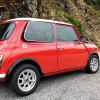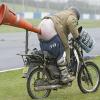Did my first CV boot replacement on my '88 Mini which I've owned for only two months. Outer left side torn and throwing grease about. This is fairly recent as it was not torn at purchase inspection in July.
While doing the work of hub removal, discovered the arm drop limiter bumper was not present. Also missing was the water splash shield inner side of the hub. Upper ball join also feeling too loose. Will need to address all of these when I do the rubber cone & shock replacements in coming weeks.
As per one online video, I attempted to remove the outer CV joint with the drive shaft still in situ, without having to remove the inner pot joint boot to allow full shaft removal. But I was unable to get good enough hammer strikes on the outer joint shoulder to pop it off the retaining clip. Not enough clearance to swing the hammer and the whole shaft would move with each blow I could apply. So off with the inner pot boot (very easy) and took it all to the bench. Next problem I had was with the metal clamps included with the boot kits I had purchased (MiniSpares). The smaller one had to be on the very smallest clip points to approach anything near proper fit. Even after crimping the clamp with proper tool, it was barely snug. The outer was even worse, as at minimum diameter clip engagement, way too much slack that crimping would not take up. So grabbed a long zip strap and made the boot hold nicely. Knew of the concerns around the zip connector interfering with the hub so used a dremel drum sander to knock down edges of the connector a fair amount.
Next issue was trying to get the newly supplied C ring to seat well enough to allow joint onto the shaft. Ring was just too open. Fiddled a while with different vise squeezes to compress the shape and finally got it to seat in the groove much better and the joint went right on.
Back on the car, the zip strap connector was clearing the hub alright. Used another zip strap on the inner pot joint. I had used a 400 ft-lbs electric impact driver (newly purchased for this job) to easily remove the axle nut and it also worked well to install it. Plan was to then move to my big torque ratchet to final set to spec (158 ft-lbs?)....but found the whole suspension would move upwards against the rubber cone as I tried to apply torque using downward force. I had a bit of 2x4 wood jammed under a wheel stud and to the ground so that rotation was prevented. Could not get anywhere near tight. So went back to the electric gun and let it keep hammering away until it seemed to barely more the nut...then a bit longer to align the split pin holes. Is this reasonable to leave it or should I find a better way to get the torque wrench to work? I cannot access this nut with wheel on as there is no removable cover on the wheel's hub.




















